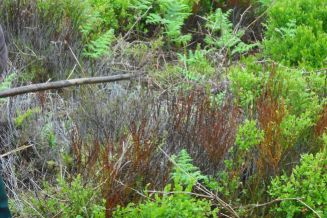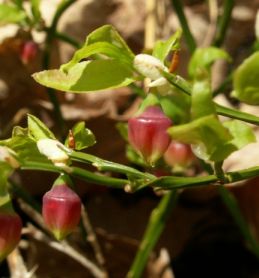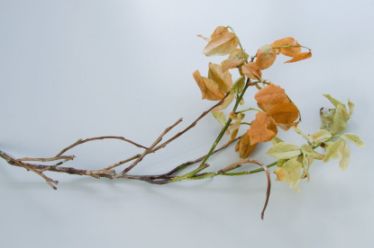Rare disease causing death of bilberry on the Roaches

Rare disease causing death of bilberry on the Roaches
How visitors can help stop spread of the disease
A fungal plant disease was identified on the Roaches, a beauty spot in the Staffordshire area of the national park, in 2011 that killed bilberry in some areas.
 The disease – called Phytophthora pseudosyringae – is harmless to humans and animals but can be spread to other plants on human clothing and the coats of animals.
The disease – called Phytophthora pseudosyringae – is harmless to humans and animals but can be spread to other plants on human clothing and the coats of animals.
The Roaches remains open to the public but people are asked to avoid contact with bilberry by staying on the footpaths when walking and accessing climbing crags and boulders, and to keep dogs on a short lead. This will help reduce the risk of the disease spreading further.
Monitoring in 2011 and 2012 indicated some spread of the disease on the estate but the majority of bilberry plants have remained healthy.
Bilberry is one of the main moorland shrubs on the estate and there were concerns the infection could spread to other moorland sites.
The Roaches is an internationally important wildlife habitat, officially designated a Site of Special Scientific Interest and a Special Area of Conservation, and a great place for local people and visitors to enjoy. Please help us keep it that way.
Frequently asked questions on new disease causing death of bilberry on the Roaches
What is the disease called and what does it do?
The disease is called Phytophthora pseudosyringae and can kill areas of bilberry.
It is a fungal plant disease that causes the roots of bilberry plants to rot and the plant to wilt and have discoloured foliage and stems.
There is no treatment for the disease but it is thought that some plants may have natural resistance.
Where is the problem?
Evidence of the disease was found near to Roach End, in Back Forest woodland and in Hen Clough woodland.
It is possible that the disease is on other parts of the estate. The estate will be regularly monitored to assess the extent of the disease and we will work with Natural England to identify any control or treatment measures necessary.
We are asking people to stay on the footpaths, avoid touching bilberry and keep dogs on a short lead to help prevent the disease from spreading.
Can I still go climbing and walking on the Roaches? Is the Roaches still open to public access?
The Roaches is open to the public but we are asking everybody who uses the estate to stick to main footpaths when walking or accessing the climbing crags or boulders. Above all do not stray into patches of bilberry or more remote moorland areas.
We are also asking dog owners to keep their pets on short leads to stop them wandering onto bilberry.
If this situation changes we will update this website and let people know through the media and through signs on site.
How does it spread?
The main way it spreads is from the root of an infected plant to the roots of a healthy plant.
But the fungal infection can also be moved and transmitted by:
- The coats or feet of animals
- The clothes and shoes of humans that have brushed against or trod on infected plants
- Water in the soil
- Rain splashing on infected leaves
- Vehicle or bicycle tyres
How can I tell if a bilberry plant is infected?

Healthy bilberry plants look like this.

While infected bilberry plant looks like this
The disease is harmless to humans, wildlife and livestock (even when eaten), although all these groups can spread the infection through contact.
Is the disease rare?
Yes, this is a non-native disease found mainly in trees in the United States and continental Europe. It was first recorded in Britain in 2005, affecting a small number of trees. This is believed to be the third case of the disease in the world. The first was at Cannock Chase in Staffordshire, and the second in the south-west of England, both in 2009. Since 2011 further infected sites have been found in the Peak District.
More information about the disease is available on the Food and Environment Research Agency website at www.fera.defra.gov.uk (type Phytophthora pseudosyringae in the search box).
Why is this a serious issue?
Bilberry is a key component of upland heath, blanket bog and woodland habitats and its loss would harm the biodiversity and natural life-cycles of the site.
Diseased sites also look unsightly – an important consideration in a tourist area.
What are you doing about it?
Bilberry will be monitored by us and by Staffordshire Wildlife Trust when they take over management of the estate in May 2013. Any action will need to be agreed with Natural England and based on a thorough scientific understanding of the disease.
Fieldworkers are disinfecting their clothing and footwear before and after contact with bilberry.
We are asking people to stay on footpaths, avoid all contact with bilberry and keep their dogs on short leads so they cannot walk on bilberry.
For more information, call the Peak District National Park Authority on 01629 816200.

